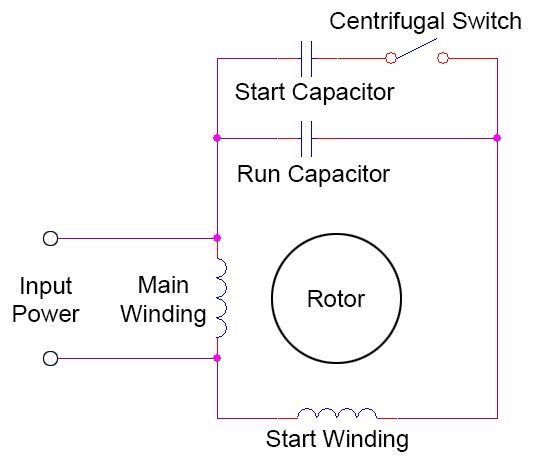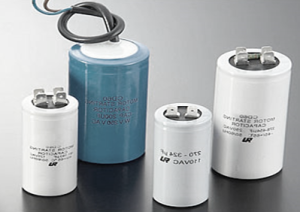- Network Sites:
-
 EEPower Day is a free 1-day virtual conference. Learn More
EEPower Day is a free 1-day virtual conference. Learn More
AC induction motors use a rotating magnetic field to produce torque. Three-phase motors are widely used because they are reliable and economical. The rotating magnetic field is easily achieved in three-phase asynchronous motors because the phase angle offset between the individual phases is 120 degrees. However, single-phase AC motors require external circuitry which creates the phase angle offset in order to produce a rotating magnetic field. This circuitry can be realized using advanced power electronics, or more simply using a motor capacitor.
The video below shows an easy to understand explanation of the working principle of the AC induction motor.
AC induction motors usually use two or more coils to generate a rotating magnetic field, which produces torque on the rotor. When a single coil is used, it will generate a pulsating magnetic field, which is enough to sustain rotation, but not sufficient to start the motor from a standstill. Motors with a single coil have to be started by using an external force, and can rotate in either direction. The direction of the rotation depends on the external force. If the motor was started in a clockwise direction, it will continue to rotate and build up speed in the clockwise direction, until it reaches a maximum speed which is defined by the power source frequency. Similarly, it will continue rotating counter-clockwise if the initial rotation was counter-clockwise. These motors are not practical due to their inability to reliably start rotation on their own.
One way to improve on the single coil design is by using an auxiliary coil in series with a motor starting capacitor. The auxiliary coil, also called starting coil, is used to create an initial rotating magnetic field. In order to create a rotating magnetic field, the current flowing through the main winding must be out of phase in respect to the current flowing through the auxiliary winding. The role of the starting capacitor is to lag the current in the auxiliary winding, bringing these two currents out of phase. When the rotor reaches sufficient speed, the auxiliary coil is disconnected from the circuit by means of a centrifugal switch, and the motor remains powered by a single coil creating a pulsating magnetic field. In this sense, the auxiliary coil in this design can be regarded as a starting coil, since it is only used during motor startup.
Another way to further improve on the single-coil single-phase induction motor design is to introduce an auxiliary coil, which remains powered not only during the motor startup phase, but also during normal operation. As opposed to an AC motor using only a motor start capacitor, which creates a pulsating magnetic field during normal operation, AC motors using a motor start capacitor and a motor run capacitor create a rotating magnetic field during normal operation. The function of the motor start capacitor remains the same as in the previous case - it gets disconnected from the circuit after the rotor reaches a predetermined speed by means of a centrifugal switch. After that point, the auxiliary winding remains powered through a motor run capacitor. The figure below describes this type of design.


Motor start capacitors are used during the motor startup phase and are disconnected from the circuit once the rotor reaches a predetermined speed, which is usually about 75% of the maximum speed for that motor type. These capacitors usually have capacitance values of over 70 µF. They come in various voltage ratings, depending on the application they were intended for.
Some single phase AC motor designs use motor run capacitors, which are left connected to the auxiliary coil even after the start capacitor is disconnected by the centrifugal switch. These designs operate by creating a rotating magnetic field. Motor run capacitors are designed for continuous duty, and remain powered whenever the motor is powered, which is why electrolytic capacitors are avoided, and low-loss polymer capacitors are used instead. The capacitance value of run capacitors is usually lower than the capacitance of start capacitors, and is often in the range of 1.5 µF to 100 µF. Choosing a wrong capacitance value for a motor can result in an uneven magnetic field, which can be observed as uneven motor rotation speed, especially under load. This can cause additional noise from the motor, performance drops and increased energy consumption, as well as additional heating, which can cause the motor to overheat.
Motor start and run capacitors are used in single-phase AC induction motors. Such motors are used whenever a single-phase power supply is more practical than a three-phase power supply, such as in domestic appliances. They are not as efficient as three-phase AC induction motors, however. In fact, single-phase AC motors are 2 to 4 times less efficient than three-phase AC motors, which is why they are used only for less powerful motors. Typical applications which utilize start and run motor capacitors include power tools, washing machines, tumble dryers, dishwashers, vacuum cleaners, air conditioners and compressors.